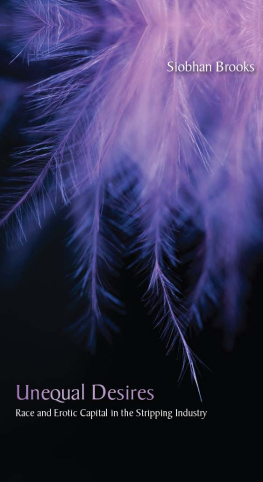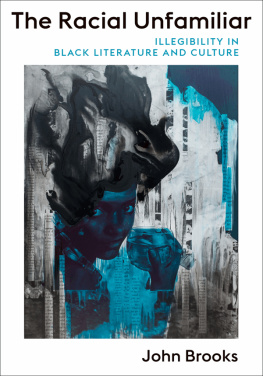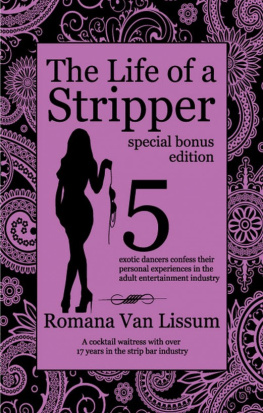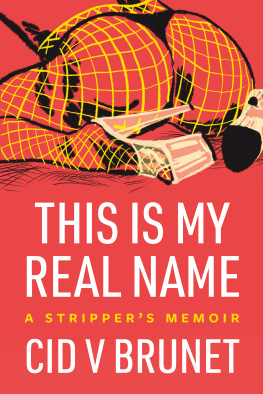
Unequal Desires
Race and Erotic Capital in the
Stripping Industry
SIOBHAN BROOKS

Author photograph (back cover): Beth Currans, photographer.
Frontispiece photograph: Karen Marisa, photographer; Teresa Ellis, model.
Published by State University of New York Press, Albany
2010 State University of New York
All rights reserved
Printed in the United States of America
No part of this book may be used or reproduced in any manner whatsoever
without written permission. No part of this book may be stored in a retrieval
system or transmitted in any form or by any means including electronic,
electrostatic, magnetic tape, mechanical, photocopying, recording, or otherwise
without the prior permission in writing of the publisher.
For information, contact State University of New York Press, Albany, NY
www.sunypress.edu
Production by Eileen Meehan
Marketing by Michael Campochiaro
Library of Congress Cataloging-in-Publication Data
Brooks, Siobhan, 1972
Unequal desires : race and erotic capital in the stripping industry /
Siobhan Brooks.
p. cm.
Includes bibliographical references and index.
ISBN 978-1-4384-3215-1 (hardcover : alk. paper)
ISBN 978-1-4384-3214-4 (pbk. : alk. paper)
1. Sex-oriented businessesHistory. 2. Race discrimination. I. Title.
HQ115.B75 2010
306.77089'00917521dc22 2009054441
10 9 8 7 6 5 4 3 2 1
I dedicate this book in memory of my mother, Aldean Brooks,
for her belief in my intellectual abilities and
unconditional love, and to sex workers of color.
Acknowledgments
I thank my interviewees, whose insights and sharing of experiences made this book possible. I am very grateful for the feminist scholars of color whose work has guided me over the years, especially within the fi elds of queer studies, ethnic studies, and sociology. I received institutional support from the Department of Feminists Studies at University of California at Santa Barbara and the Gender Studies Department at Lawrence University during the completion of this project, which was based on my dissertation at New School University in the Sociology Department. I also thank Cathy Cohen and Juan Battle, organizers of the April 2008 conference, Race, Sex, Power: New Movements in Black & Latina/o Sexualities, held at University of Illinois at Chicago, for allowing me to share my research with a broader audience. I am indebted to France Winddance Twine, who over the years has mentored me as a scholar, and I am grateful for our friendship during the past 12 years. I also thank Leila Rupp and Joane Nagel for their comments on earlier versions of the project.
I acknowledge the following people for offering me intellectual and emotional guidance throughout my research: Paul Amar, Eddy F. Alvarez, Youlanda Barber, Joan Budesa, Grace Chang, Lisa Hajjar, Zosera Kirkland, Robert Quintana Hopkins, Zakiyyah Jackson, Bahia Munem, Alice Matiz, Donna Marie Peters, Vanessa Rodriguez, Demetrius Semien, Charles Allen Swift Jr., and Mireille Miller-Young. I am also thankful to Larin McLaughlin, acquisitions editor at SUNY Press for all her support.
Finally, I thank my beloved partner, Alejandra Luna. I am deeply grateful for her love, for listening to me during my times of frustration and joy, and for always making me smile with her laughter. Gracias por tu amor y apoyo. Te amo.
Siobhan Brooks
Introduction
You have to try harder to talk to the customers and ease them into buying a lap dance from you, smile at them, engage them more, because many White men are scared of Black women and sometimes Black men don't want to see a Black woman either, whereas the White women have an easier time talking to customers. Some nights I make anywhere from $150 to $300 a night, whereas White women make around $500 a night or more.
Alicia (24-year-old Black Canadian dancer)
On August 30, 1997, dancers at the Lusty Lady Theater in San Francisco made history by unionizing with Service Employees International Union (SEIU) Local 790; the Lusty Lady became the only strip club in the United States to successfully unionize (see Brooks, 1999). I was one of those dancers. When I was 22 years old I worked as an exotic dancer at the club while majoring in women's studies at San Francisco State University. Before working at the Lusty Lady, I was familiar with the sex workers movement in the Bay Area; in 1973 Margo St. James founded the prostitutes rights group, COYOTE (Cast Off Your Old Tired Ethics), which fought to recognize sex work as labor, and eliminate the social stigma against sex workers. In the early 1990s, the movement was again in full force because of the influx of many women entering the sex industry, especially exotic dancing, as the service sector expanded. For example, in 1992, former exotic dancers Dawn Passar and Johanna Breyer founded the nonprofit organization the Exotic Dancers Alliance, and organized in response to a move by management forcing exotic dancers to pay stage fees to work in clubs.
I was familiar with the Lusty Lady because many of the students in my women's studies classes (most of whom were White) were working there; it was known as a feminist strip club because women managed it and the president of the company that owned it was a woman. Like many college students, I was struggling financially, and was told by some of the women who worked there that the Lusty Lady was a safe environment. The starting wage was $10 an hour; $25 an hour was the top wage. There was no customer contact and the hours were flexible. Because the Lusty Lady was a peep-show, surrounded with mirrors and neon lights, which operated on quarters and dollar bills, the women danced behind glass. I eventually decided to see what the club was all about and scheduled an auditiona week later I was hired by Josephine, a Black manager (called a show director) and former Lusty dancer herself.
In many ways, the club lived up to its reputation as a feminist operation: Women were escorted to their cars at night by male support staff, customers were not allowed to be disrespectful or abusive toward dancers, and overall there was a camaraderie among the dancers that made it a safe and supportive environment. During our 10-minute breaks, coffee and snacks were provided in the dressing room.
Yet, within the first month, I felt there was a major problem in the feminist equation of the Lusty Ladyout of 70 dancers only 10 were women of color, and of these, only 3 were Black. I noticed this while I was on stage; there was usually only one woman of color and four White women. If a Black dancer was performing, White (and some Asian) customers often would leave the window and move to one where a White woman was standing, sometimes talking with other White dancers, and ignoring the customer all together. In an extreme case, a White man wanted his $5 back after placing it in the bill collector, and the window revealed a dark-skinned, curvy Black woman. The degree of symbolic anti-Black racism at the Lusty Lady often was overwhelming, but not discussed among the White, Black, and non-Black dancers of color.
However, the full impact of the racism at the club was the issue of Black women performing in what was called Private Pleasures, a booth that was separate from the main stage, but a more lucrative way for dancers to perform, with wages starting at $5 for 3 minutes; dancers could make up to $60 an hour. I told Josephine that I was interested in working in the booth; she trained me, and the following week I was placed on the schedule. However, I was only scheduled on a Private Pleasures shift once, whereas other dancers worked there as often as three or four times a week. I noticed that although non-Black women of color worked in this booth, Black dancers were never scheduled. When I asked Josephine about this, she explained that because White men would pay 25 cents to see us on stage, as opposed to the $5 required in the Private Pleasures booth, having Black women dance in the booth would lead to the club loosing money.









